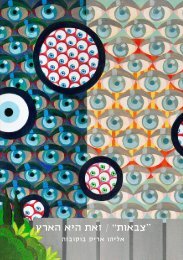eliahou eric bokobza ×ר×ק ××××× ××ק×××× eliya tsuchida ×××ת ××ר
eliahou eric bokobza ×ר×ק ××××× ××ק×××× eliya tsuchida ×××ת ××ר
eliahou eric bokobza ×ר×ק ××××× ××ק×××× eliya tsuchida ×××ת ××ר
You also want an ePaper? Increase the reach of your titles
YUMPU automatically turns print PDFs into web optimized ePapers that Google loves.
Kazuo Ishii<br />
calligraphy on wooden boxes<br />
Quotations from The Art of War by Sunzi<br />
2012<br />
The text in front of us was taken from The Art<br />
of War, a Chinese treatise from the fourth<br />
century BCE. This text was absorbed into<br />
the Japanese literary canon already during<br />
the eighth century and it is accepted as<br />
general knowledge among Japanese even today.<br />
Generals and warriors of previous generation<br />
emphasized the strategic sophistication<br />
taught in this text, but today it is often used<br />
as support to the claim that the best victory<br />
is gained “without fighting”. The artist Kazuo<br />
Ishii notes that his martial arts teacher<br />
often stressed that the best way to win a fight<br />
is by avoiding it.<br />
Ishii uses an artistic traditional form of<br />
calligraphy – styled writing. Calligraphy<br />
can be written in multiple variations of<br />
characters and of styles. The quotations on<br />
the right and left boxes were written in Kana<br />
script, namely - a combination of Japanese<br />
and Chinese characters sketched in rapid and<br />
abstract brushstrokes termed “grass script”.<br />
The Kana script is identified with classical<br />
Japanese poetry.<br />
The calligraphy on the central case was<br />
drawn in Chinese cl<strong>eric</strong>al script, in which<br />
characters are uniformly sketched with a<br />
thick brush. Ishii’s brushstrokes, however,<br />
consist of intended vibrations that create<br />
the impression of letters engraved in stone.<br />
In his view, while Chinese calligraphy is<br />
characterized by a certain depth, the Japanese<br />
style typically draws attention to the<br />
surface and its two-dimensional nature, thus<br />
overriding the illusive trickery between near<br />
and far.<br />
For Ishii, who lives fifteen years in Israel,<br />
the distance between the cultures of Israel<br />
and Japan evolved into a symbolic distance.<br />
This spiritual distance enables him to reflect<br />
upon external and internal processes within<br />
himself, within the society he left, and within<br />
the society where he chose to lead his life.<br />
קזואו אישיאי<br />
קליגרפיה על גבי תיבות עץ<br />
מתוך “חוקי המלחמה” של סון-דזה<br />
2012<br />
הטקסט שלפנינו לקוח מקובץ סיני מהמאה הרביעית לפני<br />
הספירה שעיסוקו “חוקי המלחמה”. אל הקאנון ההגותי<br />
היפני הוא התקבל במאה השמינית לספירה ורבים מצטטים<br />
ממנו גם היום. בדורות קודמים מצביאים הדגישו לא פעם<br />
את התחכום האסטרטגי שעליו מורה הטקסט, אך כיום<br />
משמשים ציטוטים אלה אמירה נגד יציאה למלחמה. האמן<br />
קזואו אישיאי מציין שלמד ממורו לאומנויות הלחימה כי<br />
הדרך הטובה ביותר לנצח היא להימנע מקרב.<br />
הציטוטים שנבחרו לתערוכה משקפים תובנות מורכבות<br />
על מלחמה ושלום, ידיעת העצמי וידיעת היריב - תובנות<br />
שאינן מוגבלות למדינה, לחברה או לתקופה.<br />
אישיאי משתמש בקליגרפיה - כתיבה מסוגננת - בסגנון<br />
אמנות מסורתי. בקליגרפיה נעשה שימוש במספר רב של<br />
אותיות ובשלל סגנונות. הציטוטים שעל התיבה הימנית<br />
והשמאלית נכתבו בקליגרפיה באותיות קאנה - שילוב<br />
של אותיות יפניות וסיניות - המשורבטות בכתב יד מהיר<br />
ומופשט המכונה “כתב העשב”. כתב הקאנה מזוהה עם<br />
השירה היפנית הקלאסית.<br />
לקליגרפיה שעל התיבה המרכזית נבחרו אותיות בסגנון<br />
כתב הפקידים הסיני. האותיות משורטטות במכחול עבה<br />
על העץ באחידות. אולם אישיאי מניע את המכחול ברטט<br />
מכוון המעניק תחושה כאילו הסימניות נחרטו באבן. על כן,<br />
בעוד הסימניות הסיניות מאופיינות בעיניו בעומק מסוים,<br />
הסגנון היפני מתאפיין דווקא בהדגשת המשטח והדו-ממד<br />
ומתוך כך מבטל את תחבולת התעתוע שבין הקרוב והרחוק.<br />
בעבור אישיאי, החי בישראל זה חמש-עשרה שנה, המרחק<br />
בין תרבויות ישראל ויפן הפך למרחק נפשי סימבולי<br />
המאפשר לו להביט בפרספקטיבה מהורהרת על התהליכים<br />
האישיים שחווה ועל התהליכים העוברים על החברה בכלל.<br />
8






